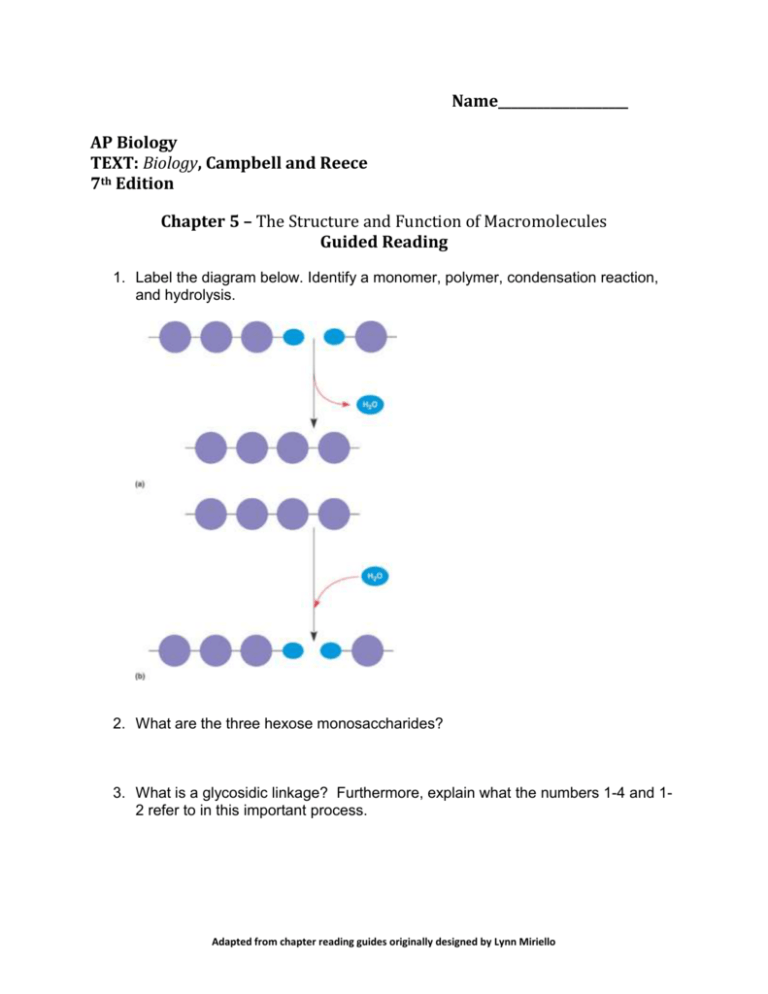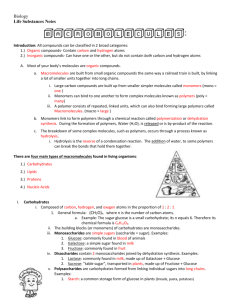AP Biology - BridgesToLiteracy.com
advertisement

Name____________________ AP Biology TEXT: Biology, Campbell and Reece 7th Edition Chapter 5 – The Structure and Function of Macromolecules Guided Reading 1. Label the diagram below. Identify a monomer, polymer, condensation reaction, and hydrolysis. 2. What are the three hexose monosaccharides? 3. What is a glycosidic linkage? Furthermore, explain what the numbers 1-4 and 12 refer to in this important process. Adapted from chapter reading guides originally designed by Lynn Miriello 4. Compare and contrast the two storage polysaccharides. 5. Compare and contrast the two structural polysaccharides. 6. Why are lipids grouped together? 7. What are the building blocks of fats? 8. Compare and contrast saturated and unsaturated fats. How does this relate to the concept that structure and function are linked? 9. Label the molecule below. 10. How would you recognize a basic steroid molecule? 11. List the eight types of proteins and the basic function of each. Adapted from chapter reading guides originally designed by Lynn Miriello 12. List the names of the monomers and polymers of proteins? 13. Label the diagram below which depicts the catalytic cycle of an enzyme. 14. Draw two amino acids making special notation of the amino group, the carboxyl group and the alpha carbon. Circle the water molecule to be removed and then note the peptide bond formed when the two are joined. 15. Explain the four levels of protein structure. a. Primary b. Secondary c. Tertiary Adapted from chapter reading guides originally designed by Lynn Miriello d. Quaternary 16. How does the characteristics of an amino acid (nonpolar, polar, acidic or basic) relate to the issue of tertiary and quaternary structure? 17. What does denaturation mean and why is it important? 18. What are chaperonins and what is their role in protein structure? 19. Describe the technique of x-ray crystallography. 20. What are the roles of nucleic acids? Adapted from chapter reading guides originally designed by Lynn Miriello 21. Label the blank diagram below: 22. What is meant by the term anti-parallel in reference to DNA? AP Biology Exam Checkpoint 23. Polymers of carbohydrates and proteins are all synthesized from monomers by a. the joining of monosaccharides. b. hydrolysis. c. dehydration reactions. d. Ionic bonding of monomers. e. cohesion. 24. Lactose and sucrose are examples of a. monosaccharides. b. nucleic acids. c. unsaturated fatty acids. d. disaccharides. e. glucose polymers. 25. Which of the macromolecules below could be structural parts of the cell, enzymes, or involved in cell movement or communication? a. nucleic acids b. proteins Adapted from chapter reading guides originally designed by Lynn Miriello c. lipids d. carbohydrates e. minerals Adapted from chapter reading guides originally designed by Lynn Miriello








